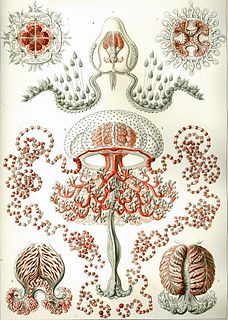
Anthoathecata, or the athecate hydroids, are an order of hydrozoans belonging to the phylum Cnidaria. A profusion of alternate scientific names exists for this long-known, heavily discussed, and spectacular group. It has also been called Gymnoblastea and, Anthomedusa,Athecata, Hydromedusa, and Stylasterina. There are about 1,200 species worldwide.

Leptothecata, or thecate hydroids, are an order of hydrozoans in the phylum Cnidaria. Their closest living relatives are the athecate hydroids which are similar enough to have always been considered closely related, and the very apomorphic Siphonophora which were placed outside the "Hydroida". Given that there are no firm rules for synonymy for high-ranked taxa, alternative names like Leptomedusa, Thecaphora or Thecata, with or without the ending emended to "-ae", are also often used for Leptothecata.

Plumularioidea is a superfamily of hydrozoans in the order Leptothecata.

Aequoreidae is a family of hydrozoans. There are approximately 30 known species found in temperate and tropical marine coastal environments. Aequoreids include Aequorea victoria, the organism from which the green fluorescent protein gene was isolated.

Pandeidae is a family of hydroids in the class Hydrozoa. Like other jellyfish there is usually a mature medusa form which is pelagic and reproduces sexually and a hydroid or polyp form which is often benthic and reproduces asexually by budding.

Bougainvillia is a genus of hydroids in the family Bougainvilliidae in the class Hydrazoa. Members of the genus are characterised by having the marginal tentacles of their medusae arranged in four bundles. Some species are solitary and others are colonial but all are filter feeders. They are found in the Southern Ocean, having a circumpolar distribution, but some species also occur in the Northern Hemisphere, possibly travelling there as polyps on the hulls of ships.

Corynidae is a family of hydrozoans in the order Anthomedusae.

Hydractiniidae is a cnidarian family of athecate hydroids.
Bougainvillia frondosa is a marine invertebrate, a species of hydroid in the suborder Anthomedusae. It was first described by Mayer in 1900.

Ectopleura is a genus of hydrozoans in the family Tubulariidae.

Capitata is a suborder of Hydrozoa, a class of marine invertebrates belonging to the phylum Cnidaria.

Filifera is a suborder of hydrozoans in the order Anthoathecata. They are found in marine, brackish and freshwater habitats.

Aplanulata is a suborder of Hydrozoa, a class of marine and freshwater invertebrates belonging to the phylum Cnidaria. The group have lost its planula larval stage, and the only remnants of the medusa stage is when they functions as gonophores attached to the polyp.
Pennaria is a genus of hydrozoans. It is the only genus within the monotypic family Pennariidae.

Corymorpha is a genus of hydrozoans in the family Corymorphidae.
Eirene is a genus of hydrozoans in the family Eirenidae.
Rhizophysidae is a family of siphonophores in the suborder Cystonectae. It includes Bathyphysa conifera, sometimes called the "flying spaghetti monster".
Octophialucium is a genus of Hydrozoan in the family Malagazziidae. The genus contains bioluminescent species.
Amphinema is a genus of cnidarians belonging to the family Pandeidae.

Zanclea is a genus of hydrozoans belonging to the family Zancleidae.













